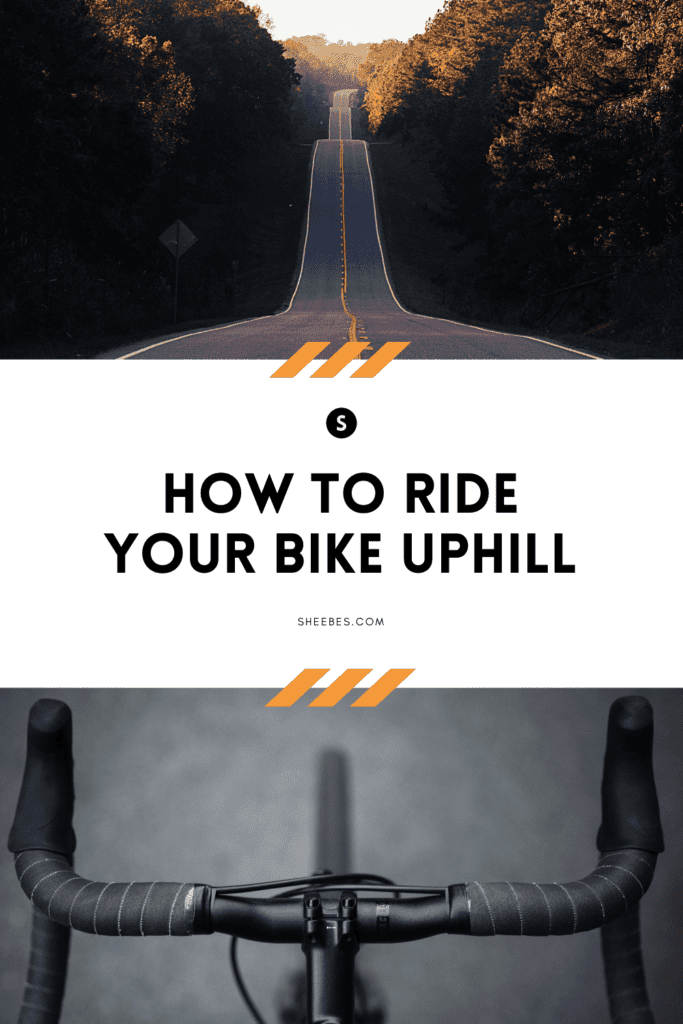You’ve been there, right? You’re pedaling away and see ahead on the horizon…a big hill.
So you take a deep breath, wince a little inside, and whoosh.
Another speedy cyclist whizzes past you and glides uphill without breaking a sweat.
Why is riding your bike uphill so challenging? (It’s because it’s you, your bike, and your gear, pushing against gravity.)
Riding a bike uphill is a skill that can and must be practiced, and with time, you can get good at it. (Those who seem to climb hills effortlessly have just practiced more.)
But with a few cycling uphill tips and tricks, you can master riding your bike uphill with greater ease.
Let’s dive into the tips for cycling uphill that will help you get up and over any hill.

Whether you’re a runner looking for running tips or a cyclist searching for cycling advice, this site is here to help you elevate your fitness game.

Affiliate Disclosure: I’m here to help you grow as a rider and runner. So to keep things running smoothly and the content free, I participate in the Amazon Services program and select affiliate networks. So, when you click on those affiliate links, I earn a small commission at no extra cost to you.
7 TOP CYCLING TIPS FOR CLIMBING

Make it into a mental game
Rather than tackling the entire hill (and wishing that it was downhill), use your scenery to your advantage with these two tips.
1| Break the hill into chunks
Small bite-sized goals help you manage the hill, the pain, and your expectations. Plus, it’s far easier to focus on small bits at a time rather than the entire hill at once.
Choose a tree, a pole, or whatever your scenery has to offer up ahead and ride toward it.
And once you’ve passed your landmark goal, set your sights on something else to ride toward.
2| Reel it in
Got your sights set on a tree? Imagine that tree has a rope around it and it’s reeling you in toward it (and over the hill).

Ride with clipless pedals
If you don’t ride with clipless pedals, this is one piece of gear that can help you both on climbs and descents.
Clipless pedals, which attach your foot to the pedal, secures your foot to your bike, so all that power that’s coming from your legs goes right into the pedals.
Without clipless pedals, you’ll waste energy trying to keep your foot flat against the pedal when you’re cycling uphill and flying downhill.
You want to focus all your energy and power into your pedals to move uphill.

Downshift before the hill
See a hill up ahead?
If you do, then it’s prime time to find a gear where you can turn your pedals quickly and easily. (In other words, keep your cadence—your number of pedal rotations in a minute—high before the hill.)
It may feel like you’re pedaling furiously and not going very far for your effort on a flat road, but this will help you as you travel uphill.
Because the steeper the hill gets, the harder it will be to turn over your pedals.
Start off easy before the hill so that pedaling doesn’t get too tiresome.
On the hill? Keep shifting to a gear where you can keep your cadence high and pedal easily.

Pace yourself on the hill
You don’t have to speed up a hill just yet. Remember, we’re practicing so that you build strength and skill for tackling hills.
Begin the hill slow and steady, so you have enough energy for the last bit of it (it’s sometimes the most challenging part of the hill).
The last thing you’d want to do is tire yourself out in the middle of a hill, with no energy to get up over it.
The more you ride uphill, the better you’ll get at it, especially if you ride the same hills often.
You’ll get to know the terrain, you’ll learn how to manage your energy, and see how much you’ve progressed since you’ve been riding your bike uphill.

You could sit in the saddle or stand
There’s much debate on whether you should sit in your saddle or stand as you’re cycling uphill.
There are advantages to both but what really matters is that you find what works for you.
You will use less energy if you stay seated, but you’ll get a boost of power (and use a lot of your energy) if you stand.
There’s no best answer here—only one that works for you.
If you decide to change positions from sitting to standing, shift into a bigger gear and stand.
And when you sit, shift back into a smaller gear and keep pedaling.

Breathe | How to breathe when cycling uphill
It’s natural for your breathing to get shorter and shallower as you climb uphill.
But you need to fill your lungs with oxygen* for energy.
Breathing as you climb a hill can be as simple as taking deep breaths in through the nose and out through the mouth.
Or try:
- Box breathing
- Inhale for 4 seconds
- Hold for another 4 seconds
- Exhale for 4 seconds
- Hold for 4 seconds
- Repeat
- Inhaling for 2 seconds, exhaling for 2 seconds
*Oxygen converts glycogen (a stored form of available glucose), into energy that you can use to make the climb.

Put everything you know about climbing hills on a bike with hill repeats
Hill repeats are specific hill workouts where you climb the same hill a few times.
This type of workout helps you build your uphill bike skills, your strength, and endurance.
Do hill repeats once a week to improve your climbing ability.
HILL REPEAT WORKOUT
Do a 10-minute easy warm-up on a flat road
Find a small hill that will take a minute or two to climb
Before the hill, find a gear where you can turn your pedals quickly and easily
Start your climb, slowly for now (you’ll get faster the more you do hills)
Recover on the downhill, rest for one minute
Repeat 4 times (or more if you want to progress your fitness)
Cool down for 10 minutes after this hill repeat workout
Finally, should you get a lighter bike? Or lose weight to make climbing hills a little easier?
Here’s the deal.
“A bike that is 2 or three pounds lighter won’t make you significantly faster,” says Jim Gourley, author of Faster: Demystifying the Science of Triathlon Speed.
“The difference between an entry-level bike and a top-of-the-line carbon model is just shy of 3.25 pounds,” he says.
He calculated how long it will take a cyclist to climb a one-mile hill, using four bikes of different weights—15-,16,-17-, and 18-pound bikes.
And he found that a bike that is one pound lighter, climbing a hill of 7 percent grade, will only save about 2.5 seconds. 1
Now, most of the weight you’re pulling uphill isn’t your bike, but your body weight.
So should you lose weight to become faster on hills?
Cycling uphill is just one part of the sport–cycling also includes sprints, going long distances, and cycling for fitness, without pressure to perform.
And you have individual, unique strengths as a cyclist.
You need fuel for energy and strength to support everything you do in a day.
So eating enough, fueling your body, staying hydrated, and enjoying food are all more important than a number on the scale and shaving seconds off a climb.
Riding a bike uphill is challenging for any cyclist—it’s you, your bike, and your gear versus gravity.
But the good news is, climbing uphill on a bike is a technique and skill that can be practiced and mastered for more strength and speed on hills and flat roads.
- Will a lighter bike make me faster?, Outside Online ↩